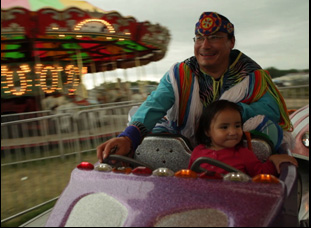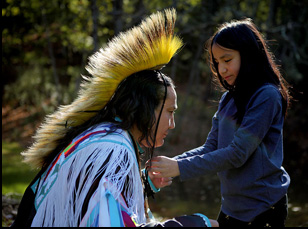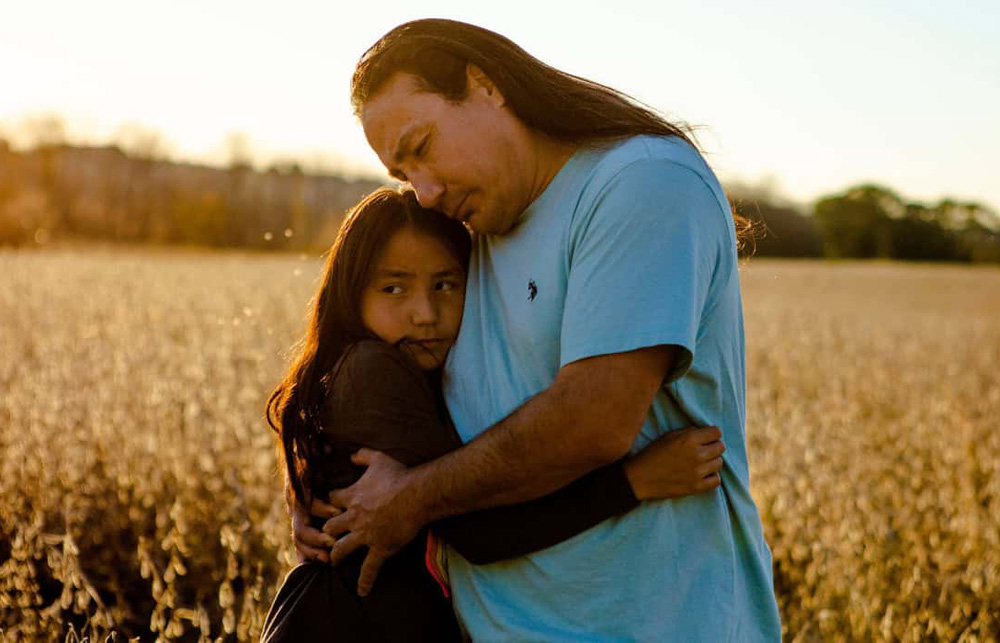When Jonathan Olshefski has had the privilege of being invited into families for years at a time to share their story, it’s inevitable that the resulting films feel as if he’s extending that invitation as broadly as possible.
“It’s extended family,” Olshefski said of his latest “Without Arrows,” co-directed with Elizabeth Day, which premieres this evening on PBS. “And it’s really beautiful to share that on Independent Lens with the rest of the country, to be like, ‘Hey, here’s this thing that’s very precious and we’re in a vulnerable way sharing it with you. Please be gentle. Hopefully it can be meaningful and impact other people’s lives.”
It would be impossible not to be moved by the time Olshefski and Day allow with the Fiddlers, following Delwin Jr., who has made a life for himself in Philadelphia, back home to South Dakota where his family of the Great Sioux Nation still lives on the rez. While Delwin Jr. has spread the beauty of his culture as a grass dancer, going on the road to keep tradition alive with performances, he contends with more painful legacies when asked by his mother Shirley to return, once having held his younger brother Frankie in his arms as he died at 14 and his father Delwin Sr. refuses to talk about the past as he still has to do punishing physical work well after he’s reached retirement age.
Over the course of 13 years, “Without Arrows” watches as Delwin Jr. handles his responsibilities as a son and becomes a father to Kassie, who turns from a tot to a teen in the blink of an eye during the 86-minute film. With Day, Olshefski, who previously made the magnificent 2017 longitudinal doc “Quest” about a Philadelphia family that hasn’t had anything handed to them as they try to build a life for themselves, sees a similar situation play out with the Fiddlers where the only opportunities to break a vicious cycle are the ones that create for themselves. As Delwin takes what work is available — jobs in pest control and at Sam’s Club when he rarely gets calls back from applications for other employment — the feeling he’s running in place when he’s got so much more to offer can really be seen with time, but an appreciation also grows for what it takes to endure and persist when life never gets any easier and the Fiddlers find what pockets of joy they can within it.
After a celebrated festival run that began last spring at Big Sky Film Fest, “Without Arrows” is now coming to homes everywhere via PBS and Olshefski and Day graciously took the time to talk about the privilege of projecting an image of the indigenous community that they can see themselves in, how Independent Lens played a role in making the film possible beyond coming on as a producer and how collaboration made the film stronger.

Jonathan Olshefski: If Independent Lens didn’t exist, “Without Arrows” probably would not exist. In 2010, Independent Lens had their community cinema series, and I ended up being a facilitator for that series in North Philadelphia, the same neighborhood where I filmed “Quest.” I was bringing documentaries to that community and having events and conversations and one of the films was “Reel Injun,” which is a film about Native American representation in media. For that event, I really wanted to bring somebody that could speak to the Native Indigenous experience and a friend of mine said, “Hey, there’s a Native dance troupe in West Philly called Native Nations Dance Theater. Why don’t you invite those guys to come on out?” So I sent an e-mail, and Delwin Fiddler Jr. and Vaughnda Hilton showed up. We had a really amazing conversation, and I just thought, “Hey, thanks for coming out. Maybe we’ll bump into each other again someday.”
Then a couple of months later, I get a phone call from a number that I didn’t recognize and the guy on the other end just says, “Hey, John, when are we going to make our movie?” And I was [said], “Wait, who are you? What’s going on?” And so here we have Delwin Fiddler Jr. making stuff happen. [laughs] He had this vision of wanting to go back to the reservation where he grew up and record some family history stories with his mom and dad. I was really excited. I’d never been to South Dakota and I also showed him some of my old verite observational documentaries. I pitched the idea of “Why don’t I just film with you in Philadelphia a little bit and then the entire trip [to South Dakota]? We’ll film some interviews and make a short film that reflects what you want to do.” And we were off.
It was the longest [Delwin] had ever been home since he had left over 10 years prior, and it was really beautiful to see him reconnecting with his mom and dad and the community and seeing him get back on a horse. After that trip, I [thought], “Oh, we have like great material for a short film.” But then two months later, Delwin gets a one-way plane ticket to move back to South Dakota. He just completely gave up his life in Philadelphia because he missed his mom and dad and wanted to reconnect with that community, so that was the beginning. And then it was like, “Okay, maybe we don’t have a short film. Maybe this is the beginning of something else.” Then we tracked Delwin’s life over what ended up being 13 years to finally make “Without Arrows.”
Elizabeth, some of this occurred before you came on, but what got you interested in this?
Elizabeth Day: Yeah, I joined the team in 2019. We were connected through Shirley Sneve, who was then the executive director of Vision Maker Media, and when Shirley sends you an e-mail saying you should connect with someone, you listen. Jonathan and I e-mailed back and forth a couple of times, and I was visiting my family in Northern Minnesota on my reservation, which is Leech Lake. I was chatting with my dad about possibly taking on another project and I said, “Do you want to watch some footage with me?” And he [said], “Sure.” So we popped on this footage of Delwin Sr. combing his hair and slicking it back and he had a cigarette hanging out of his lips. My dad leaned forward and he was so excited and happy to see a Native man who looked like his uncle and reminded him of his older brother. Watching my dad see himself represented in that moment just made my heart explode, so I knew the importance and significance of helping to make a film with Native representation. Then watching John’s work sample with some exciting scenes in it made me go, “Okay, I’m in this. Let’s do this.”
You obviously make a real dynamic duo. What was your collaboration like?
Elizabeth Day: I think we make a great team. I understand why Jonathan is such a great documentary filmmaker. We would just chat on the phone and all of a sudden I was like sharing my life story with him and I’m like, “Oh my God, why am I talking to this guy on the phone and telling him all my stuff too?” Jonathan is just really easy to talk to and creates a really safe environment for people to have a conversation. It’s also really fun to work with Jonathan. We also have a very respectful relationship in the sense where we can kind of question each other and be like, “Can you think about why you think that would be an important scene to take out or to put back in?”
Jonathan Olshefski: Yeah, Elizabeth’s a great collaborator and making this film, I knew that me as a white guy coming into the Cheyenne River Sioux Tribe reservation, I am very much an outsider, even more so than in North Philly with “Quest.” At least I lived in Philly. So I knew I needed Native collaborators to do justice to the story, and Elizabeth, because of her life experience, there’s just things she knows in her bones about what it means to be Native and what a gift to bring her into these conversations and to the filmmaking and to the edit because the film that I would have made by myself would have been a different film. It would have been 10 hours long too. [laughs] We had lots of like really deep conversations about how we’re collaborating and our hopes for larger society, how people can connect and work together in a way that’s respectful [where] you’re true to yourself, but can also give up power and be like, “Okay, I hear you,” and “That’s important to me, but it seems like it’s more important for you to get what you want and need right now.”
That back and forth was an essential piece. Making a film is hard. It’s emotionally hard. It’s physically hard. We had some wild travel we could talk about, staying outside in North Jersey when we were doing post and it’s an adventure, so you want to be on that journey with people that are trustworthy, good people that have your back. Elizabeth’s also incredibly talented and insightful and “Without Arrows” is what it is because we have this combination of fingerprints. That also includes our editing team and our composer, and we’d have nothing without the Fiddler family.

Elizabeth Day: Our amazing edit team, Leya [Hale] and Ellen [Knechel], took all of the footage and we took a week to all watch the footage together in St. Paul. From there, our edit teammade a 14-hour cut that Jon and Ellen watched over a weekend at his place in Philly and Leia and I took the weekend to watch it at my house in St. Paul and then we made an eight-hour cut, then a six-hour cut, and did we do a four-hour cut or just jump right into a couple?
Jonathan Olshefski: Who knows? It’s hard to even talk about the movie because I’m thinking of [a different] version and it’s like looking through so many different transparencies into infinity. But the essential piece was reflecting the Fiddlers’ point of view, and coming back to Delwin’s journey. There were so many interesting stories with the relatives and the brothers and his niece, but ultimately Delwin was the visionary behind this film and the final edit really tracks very close to him, but allows us time to connect with the people that he loves and cares about. That ended up becoming a guiding principle of [asking ourselves] “Where’s Delwin? Okay, we lost Delwin for a while in this cut.” But editing was hard. We edited for two years.
You got it to such a great place. Once you actually got it to a final cut, what was it like showing the family?
Jonathan Olshefski: I feel really happy that I did show multiple versions to Shirley while she was still alive. Even back when she was on the reservation and just seeing her respond to the footage was really beautiful. And then Delwin saw versions along the way, but when we got to that final cut, I remember that screening. Kassie was there, and the family that they were living with and it just felt very warm, like “Alright, we’re here. We finally did this.” And then in September of this year, we did a thing I call the Fiddler Family Reunion Tour [where] Delwin and I flew to South Dakota with the film and just showed a variety of family members and friends. We traveled all over the state, just showing people wherever we could find them and it was just really beautiful to watch them watch it. Because these are people they love that they’re seeing on screen and even seeing themselves in a previous time. It’s very emotional and really powerful.
I think everybody felt really honored and happy to have this document of their lives and the lives of loved ones. One thing that really stood out to me is that Delwin had some relatives that had young kids who knew Shirley, or remember when she was in the nursing home, so for these young children to be able to see her when she was younger and hear her stories was really powerful.
Elizabeth Day: We really made this film for a Native audience and it’s been so special, especially the audiences in Minnesota that I’ve gotten to watch it with. To watch it in a crowded theater with Native people was amazing. I know Jonathan was there for our screening at the Minnesota Film Festival in Duluth, and there was one scene we call the buffalo scene when [Delwin is] really struggling to get the hide in the trunk, and the whole audience was laughing hysterically. The lady in front of me, slapped her knee and was like, “Bend down!” And I was like, “Really?” This is our people. So showing to Native audiences is the best. Because they get it. We didn’t cut the film to explain things. And if you’re outside of that world, you may have to lean in a little bit and just be like, “Alright, maybe I’ve got to do some research outside of this.” But Native audiences, they get it and it’s really, really incredible.
“Without Arrows” premieres on Independent Lens on PBS on January 13th and will be available on PBS to stream thereafter. It is also now available on DVD and other streaming platforms via First Run Features.




